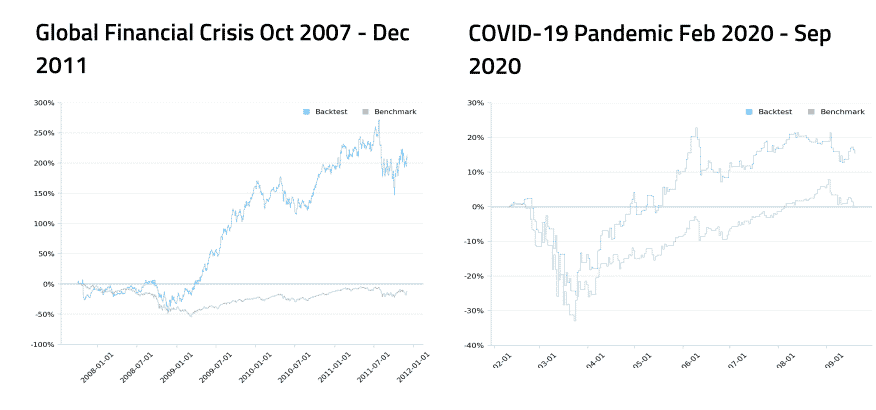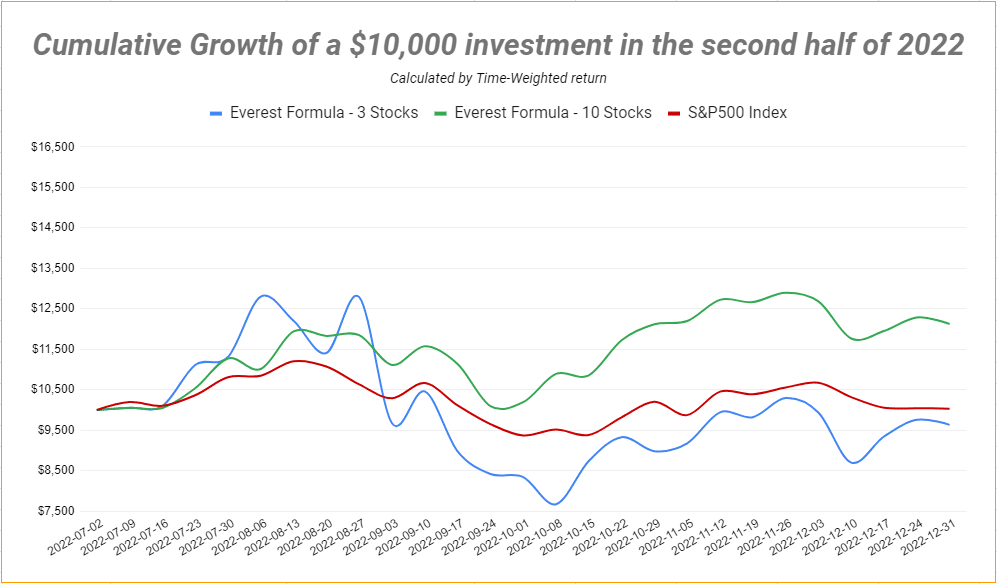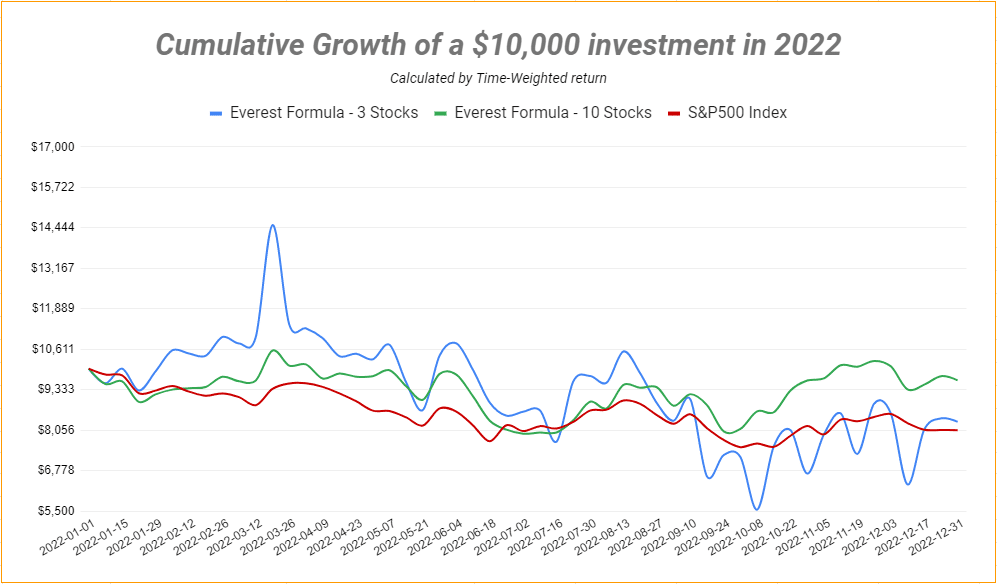- The year 2022 was a particularly turbulent year for the stock market. However, despite high volatility and a significant market drop, the Everest Formula still beat the U.S. stock index, albeit by having a negative return.
- From July 1 to December 31, the Everest Strategy registered an average gain of +8.8%, setting the consolidated performance for the whole of 2022 at an average of -10.3%, compared to the -19.5% of the S&P500 index.
- This article reviews the 2022 performance, crunching numbers for the two most popular Everest Strategies: the 3-stock strategy and the 10-stock strategy.
Don't miss new Blog Posts in your email
Performance over the last six months
In the second half of 2022, the Everest Formula 3-stock strategy had a performance of -3.7%, turning a hypothetical portfolio of $10,000 invested on July 1, 2022, into $9,632 on January 1, 2023. The 10-stock Everest Formula strategy had an astounding performance instead, registering a gain of +21.2% and turning the same amount into $12,213. In the same period, the S&P500 index registered a performance of +0.3%, keeping the portfolio substantially flat.
What is the reason for this significant difference between the performance of the 3-stock strategy and the 10-stock strategy? The question is legitimate, and the causes of this behavior can be traced to 3 factors:
- Many energy stocks joined the 10-stock portfolio in 2022, and this sector was the only one in the market that had a positive performance. Through the analysis of essential metrics such as ROTCE and FCF/EV ratio, Everest Formula recognized the undervaluation of many energy companies during the year and included them in the top 10 ranking for most of the year. Some examples are APA Corporation (in the portfolio from May to October), Magnolia Oil&Gas (in the portfolio from May to December), Devon Energy (in the portfolio in August), Enerplus (in the portfolio from August to November), which trailed the portfolio in the second part of the year. Unfortunately, these companies never ended up in the top 3, so the same gain did not occur in the first strategy.
- As we have repeatedly reported, the 10-stock strategy carries less volatility for smaller average gains and is better suited for more risk-averse investors. Therefore, it is not surprising that the 10-stock strategy performs better during market crashes when volatility tends to be very high.
- The negative performance of the year for the 3-stock strategy was caused by a few “unlucky” choices by the formula that brought most of the losses. Two out of all: Coinbase in the first part of the year and ZIM in the second part. Although these companies are well-run and have seemingly excellent valuation metrics, they are particular companies whose pricing is almost exclusively linked to the value of Bitcoin (for Coinbase) and freight rates (for ZIM). The companies were ruled out in May and September (respectively) by the formula’s precision filter, which prevented further losses, but the major losses had already occurred by that time. The weight of losses from these isolated cases in the 10-stock strategy is mitigated by the larger number of stocks that make up the portfolio. In contrast, the 3-stock strategy, with each company having a more significant weight, is more exposed to this risk.
Regarding this last point, many investors advocate that the major limitation of quantitative strategies, such as the Everest Formula, is that they cannot identify with human qualitative assessments the dangerous cases of companies that look good but conceal significant risks. Although this is true, it should be noted that there are opposite situations where the human eye, even when experienced and competent, is notoriously biased in the financial sector by cognitive and subjective biases and fails to identify obvious opportunities for a quantitative algorithm.
Everest Formula backtests seem to show that the latter are more frequent than the former.
2022 consolidated performance
Totaling up together the performance of the two semesters of 2022, the Everest Formula 3-stock strategy returned to its investors a performance of -16.8%, transforming a hypothetical portfolio of 10,000$ at the beginning of 2022 into 8,320$ at the end of 2022. The Everest Formula 10-stock strategy instead registered a performance of -3.7%, an excellent result given the overall market behavior, transforming the same amount into 9,629$. Over the same period, the S&P500 index had a substantial decline and registered a loss of -19.5%, significantly higher than the Everest Formula.
To be as transparent as possible, this result might not be considered satisfactory for a strategy that has returned more than 30% annually on average over the past 22 years, especially for users enrolled at the beginning of 2021 who made gains of up to 67% in a single year before entering in 2022.
However, analyzing the backtests during market crashes, we find that the current downtrend has always occurred in the two recessions that have characterized the last two decades: indeed, in 2008, with the financial crisis, the S&P500 index posted a 50% loss. Everest Formula lost in the same period 47% before making a significant rebound and coming out of the downtrend more strongly than the corresponding index. The same behavior occurred in the 2020 crash, with the S&P500 index collapsing in one month by 34%. During this period, the Everest Formula fell 26% before recovering quickly and bringing extremely positive performance in 2021.

This behavior has always occurred since the existence of the stock market: during crashes, fear rises in investors, who tend to sell all of their stocks, including those with the best prospects or that seem unaffected by the crisis. During these periods, the best investors like Warren Buffett built their fortunes, hence the famous saying: “Buy when you see blood flowing in the streets.”
Conclusions
In the second half of 2022, the Everest Formula returned to positive territory after a difficult first semester and still managed to beat the market, both for the semester and the whole year. Looking at the entire year, the performance is still negative, even though significantly better than the S&P500. Looking at backtests during the last crises, this was an expected behavior that could follow a big rebound in performance. This could be the best time to start following the Everest Formula strategy.
If you want to find the best profitable and undervalued stocks, join us now.
What to read next: Top 5 Stocks To Buy For 2023.





